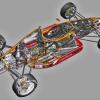Sober, if somewhat cynical...
I will try to put soemthing together on the BLAT car tomorrow - i have the eagle book published a couple of years ago which is good on this car, saves me digging into autosport.
Many tomorrows after... I stumbled on this thread looking for info on BLAT.
There seems to be nothing on the net about how it worked, so if someone has printed info, help would be truly appreciated.
In the while, I'll try guessing at how it could have worked: I doubt BLAT cars were "box cars" just propagating the rear wake pressure to a sealed underside.
Wake pressure is only slightly lower than ambient pressure and this system would have been not efficient enough to fight against Venturi cars as the Eagles did.
So I think they used vortexes. It is known that at some ramp angles strong vortexes are generated. This is the reason why Fastback bodies need to be inclined under 20 degrees , or it becomes better to have an hatchback instead.
Vortexes have low pressure inside; of course they also come with a drag penalty, but this could have been a viable system. This is backed also by some people calling BLAT cars "Vortex cars".
So my bet is on a sort of flat bottom F1 car with long diffusers.
Eagle's triangular top view shape could have helped in vortex formation.
Still, BLAT means "boundary layer adhesion technology" and I cannot see the role of boundary layer adhesion in this, unless it refers to some critical angle just before flow separation.
Those are speculations, of course.... any real info out there?




















